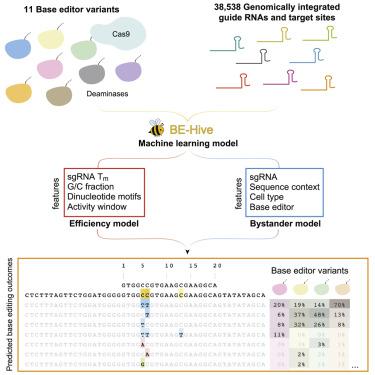Cell ( IF 45.5 ) Pub Date : 2020-06-12 , DOI: 10.1016/j.cell.2020.05.037 Mandana Arbab 1 , Max W Shen 2 , Beverly Mok 1 , Christopher Wilson 1 , Żaneta Matuszek 3 , Christopher A Cassa 4 , David R Liu 1

|
Although base editors are widely used to install targeted point mutations, the factors that determine base editing outcomes are not well understood. We characterized sequence-activity relationships of 11 cytosine and adenine base editors (CBEs and ABEs) on 38,538 genomically integrated targets in mammalian cells and used the resulting outcomes to train BE-Hive, a machine learning model that accurately predicts base editing genotypic outcomes (R ≈ 0.9) and efficiency (R ≈ 0.7). We corrected 3,388 disease-associated SNVs with ≥90% precision, including 675 alleles with bystander nucleotides that BE-Hive correctly predicted would not be edited. We discovered determinants of previously unpredictable C-to-G, or C-to-A editing and used these discoveries to correct coding sequences of 174 pathogenic transversion SNVs with ≥90% precision. Finally, we used insights from BE-Hive to engineer novel CBE variants that modulate editing outcomes. These discoveries illuminate base editing, enable editing at previously intractable targets, and provide new base editors with improved editing capabilities.
中文翻译:

目标库分析和机器学习的碱基编辑结果的决定因素。
尽管碱基编辑器被广泛用于安装靶向点突变,但决定碱基编辑结果的因素尚不清楚。我们表征了哺乳动物细胞中 38,538 个基因组整合靶点上 11 个胞嘧啶和腺嘌呤碱基编辑器(CBE 和 ABE)的序列-活性关系,并使用所得结果来训练 BE-Hive,这是一种能够准确预测碱基编辑基因型结果的机器学习模型( R ≈ 0.9)和效率( R ≈ 0.7)。我们以 ≥90% 的精确度纠正了 3,388 个与疾病相关的 SNV,其中包括 675 个带有 BE-Hive 正确预测不会被编辑的旁观者核苷酸的等位基因。我们发现了以前不可预测的 C 到 G 或 C 到 A 编辑的决定因素,并利用这些发现以 ≥ 90% 的精度纠正了 174 个致病性颠换 SNV 的编码序列。最后,我们利用 BE-Hive 的见解来设计新颖的 CBE 变体来调节编辑结果。这些发现阐明了碱基编辑,使得能够对以前难以处理的目标进行编辑,并为新的碱基编辑器提供了改进的编辑功能。











































 京公网安备 11010802027423号
京公网安备 11010802027423号